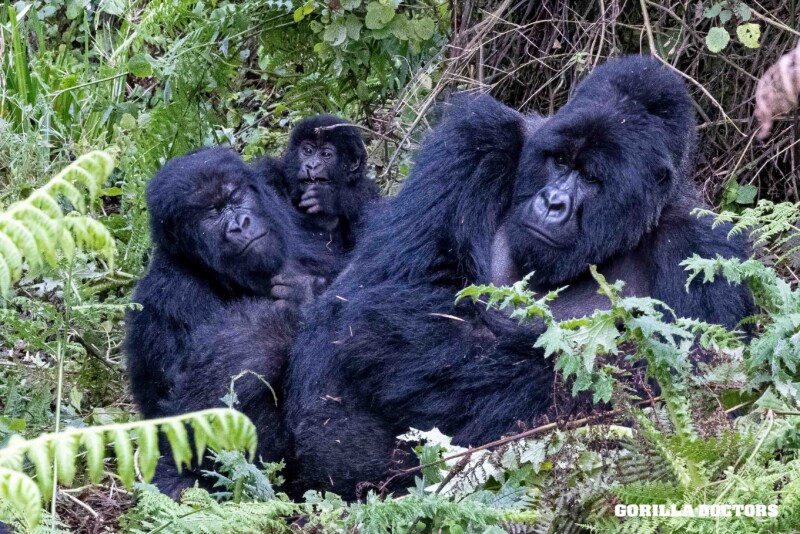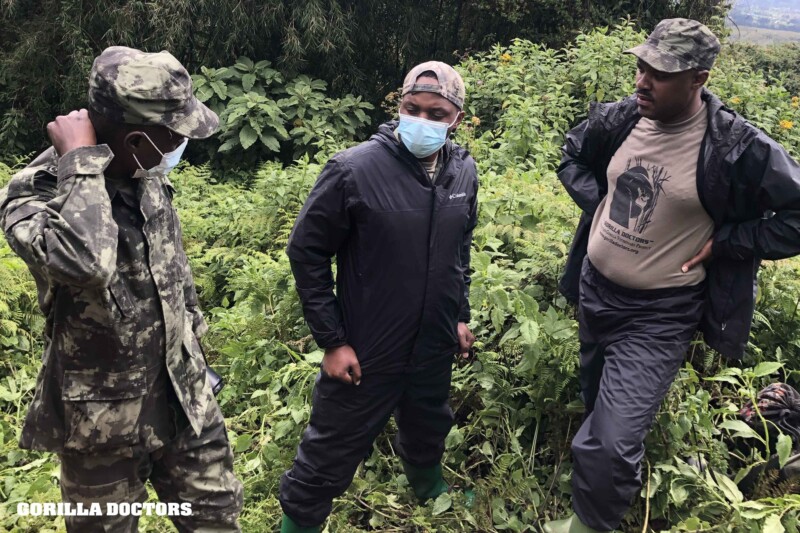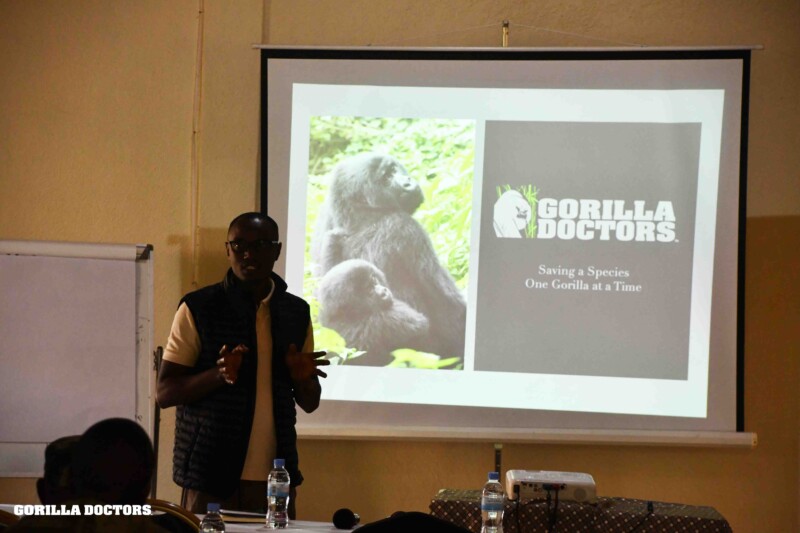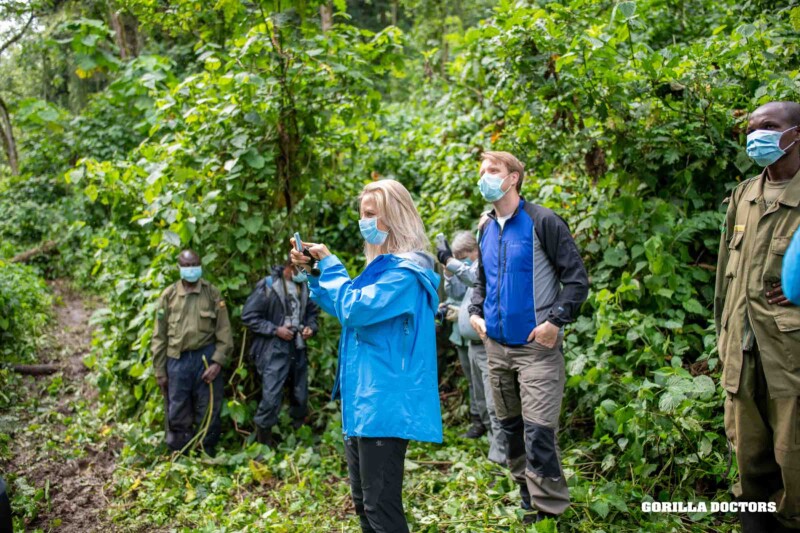It Takes a Village to Keep Gorillas Healthy
By Gorilla Doctors Staff on Friday, July 7th, 2023 in Blog.Notes from the Field: By Dr. Gaspard Nzayisenga, field veterinarian, Rwanda
For their effective conservation, mountain gorillas in Volcanoes National Park, Rwanda are monitored on a daily basis by park trackers and rangers as well as researchers and Gorilla Doctors’ veterinarians. Tourists from around the world also visit gorillas daily.

Mountain gorilla family, Hirwa group. Volcanoes National Park, Rwanda. Photo by Will Wilson for Gorilla Doctors.
Gorillas are susceptible to human diseases and close indirect contact between people and gorillas increases the risk of disease transmission. However, our ability to observe gorillas from this close distance (7-10m) is what allows for Gorilla Doctors, park staff and researchers to do their work and for tourists to have the privilege of seeing these magnificent animals in the wild. In fact, mountain gorillas are the only great ape population in the wild whose numbers are increasing, and both daily monitoring and our veterinary care play a significant role in the conservation success of mountain gorillas.
There are two field veterinarians on the Rwanda team, myself and Dr. Adrien. When we have a clinical intervention or post-mortem to conduct, we are always joined in the field by our Head Veterinarian, Dr. Julius. There are 24 mountain gorilla family groups in Volcanoes National Park that are habituated to the presence of humans. And in these groups we monitor the health of just over 250 individual gorilla ‘patients’. Since we cannot visit each group daily, we work closely with the trackers who do, and who can report any signs of illness or injury to Gorilla Doctors.
Every evening, we receive a daily report from the park with all observations recorded that day. If all is well and the gorillas are generally healthy, we simply wait for the daily report. When there is a serious health concern or a health emergency, the park personnel call us right away and we go immediately to the forest to conduct a veterinary monitoring visit or a follow-up. We spend time observing the individual gorilla, verifying the clinical signs reported and making a determination to either continue close observation or provide treatment.

Drs. Gaspard, Adrien and Julius discuss the possible need to conduct an intervention on a sick mountain gorilla in Susa group, Volcanoes National Park, Rwanda. © Gorilla Doctors
In order for park staff to help be our eyes and ears in the forest, at least twice a year we conduct a ‘refresher’ training course with park staff and our conservation partners. This course serves to:
- Train new trackers
- Update park staff on gorilla health clinical cases
- Review critical health safety best practices when guiding tourists
- Work through any challenges they face
Our most recent training was facilitated in partnership with the International Gorilla Conservation Programme (IGCP), another important mountain gorilla conservation organization in the region. Volcanoes National Parks’ Chief Park Warden, Mr. Prosper Uwingeli, also provided leadership and spoke on the importance of the trackers in helping to keep the gorillas healthy.
The vet team began by sharing a review of clinical cases ranging from January 2022 through March 2023, detailing respiratory outbreaks, clinical interventions performed and post-mortem results from gorillas lost during that time period. We also discussed some of the most important clinical signs to be aware of when conducting visual health assessments. A key piece of their training includes the accurate recording of gorilla health data. So, we then walked them step-by-step through the data collection program focusing on what information to collect and how to properly record it. One of the persistent challenges facing trackers are the forest conditions in which they have to observe the gorillas – dense vegetation, steep terrain and often wet weather.
One of the experienced park guides led a discussion of best practice measures for keeping gorillas healthy during tourist visitations. While it is impossible to fully eliminate the risk of disease, recommended best practices are aimed at minimizing the risks. Tourists play an important role and rely on the expertise of the trackers and their guides. Some of the primary best practices include maintaining a recommended minimum distance of 7 meters from the gorillas (including moving away when the gorillas come closer) and wearing a mask at all times when in the presence of gorillas (tourists do not have to wear the masks while trekking to the gorilla group).
From March 2020 – December 2021, mountain gorillas in Volcanoes National Park had fewer respiratory outbreaks than in previous years. In 2020, the park instituted mandatory use of masks while in the presence of gorillas which surely played a significant role in reducing the risk of transmission of all air borne pathogens, not just the virus that causes COVID-19 in humans. Mask wearing does not just protect people – it helps gorillas too! You can learn more about the results of this report HERE.
One of the most important bits of feedback we received from park staff is the need to conduct our refresher training courses more often. As is true for all of our operations, including trainings like these, donor funding is critical for enabling us to do this kind of cooperative work with park staff in all of the parks where we work in Rwanda, Uganda and DR Congo.
Watch this video of a past intervention where Dr. Noel administered medication via dart while rangers stood close by helping to keep an eye on the gorillas:


 Donate
Donate

